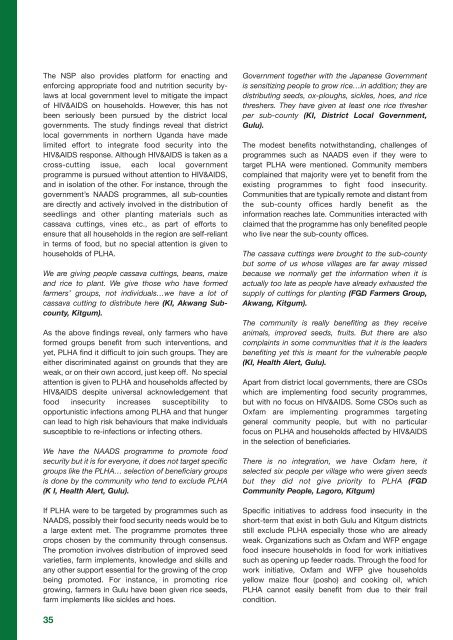Uganda Report 2012 FINAL PO:Layout 1 - ACORD
Uganda Report 2012 FINAL PO:Layout 1 - ACORD
Uganda Report 2012 FINAL PO:Layout 1 - ACORD
Create successful ePaper yourself
Turn your PDF publications into a flip-book with our unique Google optimized e-Paper software.
The NSP also provides platform for enacting and<br />
enforcing appropriate food and nutrition security bylaws<br />
at local government level to mitigate the impact<br />
of HIV&AIDS on households. However, this has not<br />
been seriously been pursued by the district local<br />
governments. The study findings reveal that district<br />
local governments in northern <strong>Uganda</strong> have made<br />
limited effort to integrate food security into the<br />
HIV&AIDS response. Although HIV&AIDS is taken as a<br />
cross-cutting issue, each local government<br />
programme is pursued without attention to HIV&AIDS,<br />
and in isolation of the other. For instance, through the<br />
government’s NAADS programmes, all sub-counties<br />
are directly and actively involved in the distribution of<br />
seedlings and other planting materials such as<br />
cassava cuttings, vines etc., as part of efforts to<br />
ensure that all households in the region are self-reliant<br />
in terms of food, but no special attention is given to<br />
households of PLHA.<br />
We are giving people cassava cuttings, beans, maize<br />
and rice to plant. We give those who have formed<br />
farmers’ groups, not individuals…we have a lot of<br />
cassava cutting to distribute here (KI, Akwang Subcounty,<br />
Kitgum).<br />
As the above findings reveal, only farmers who have<br />
formed groups benefit from such interventions, and<br />
yet, PLHA find it difficult to join such groups. They are<br />
either discriminated against on grounds that they are<br />
weak, or on their own accord, just keep off. No special<br />
attention is given to PLHA and households affected by<br />
HIV&AIDS despite universal acknowledgement that<br />
food insecurity increases susceptibility to<br />
opportunistic infections among PLHA and that hunger<br />
can lead to high risk behaviours that make individuals<br />
susceptible to re-infections or infecting others.<br />
We have the NAADS programme to promote food<br />
security but it is for everyone, it does not target specific<br />
groups like the PLHA… selection of beneficiary groups<br />
is done by the community who tend to exclude PLHA<br />
(K I, Health Alert, Gulu).<br />
If PLHA were to be targeted by programmes such as<br />
NAADS, possibly their food security needs would be to<br />
a large extent met. The programme promotes three<br />
crops chosen by the community through consensus.<br />
The promotion involves distribution of improved seed<br />
varieties, farm implements, knowledge and skills and<br />
any other support essential for the growing of the crop<br />
being promoted. For instance, in promoting rice<br />
growing, farmers in Gulu have been given rice seeds,<br />
farm implements like sickles and hoes.<br />
Government together with the Japanese Government<br />
is sensitizing people to grow rice…in addition; they are<br />
distributing seeds, ox-ploughs, sickles, hoes, and rice<br />
threshers. They have given at least one rice thresher<br />
per sub-county (KI, District Local Government,<br />
Gulu).<br />
The modest benefits notwithstanding, challenges of<br />
programmes such as NAADS even if they were to<br />
target PLHA were mentioned. Community members<br />
complained that majority were yet to benefit from the<br />
existing programmes to fight food insecurity.<br />
Communities that are typically remote and distant from<br />
the sub-county offices hardly benefit as the<br />
information reaches late. Communities interacted with<br />
claimed that the programme has only benefited people<br />
who live near the sub-county offices.<br />
The cassava cuttings were brought to the sub-county<br />
but some of us whose villages are far away missed<br />
because we normally get the information when it is<br />
actually too late as people have already exhausted the<br />
supply of cuttings for planting (FGD Farmers Group,<br />
Akwang, Kitgum).<br />
The community is really benefiting as they receive<br />
animals, improved seeds, fruits. But there are also<br />
complaints in some communities that it is the leaders<br />
benefiting yet this is meant for the vulnerable people<br />
(KI, Health Alert, Gulu).<br />
Apart from district local governments, there are CSOs<br />
which are implementing food security programmes,<br />
but with no focus on HIV&AIDS. Some CSOs such as<br />
Oxfam are implementing programmes targeting<br />
general community people, but with no particular<br />
focus on PLHA and households affected by HIV&AIDS<br />
in the selection of beneficiaries.<br />
There is no integration, we have Oxfam here, it<br />
selected six people per village who were given seeds<br />
but they did not give priority to PLHA (FGD<br />
Community People, Lagoro, Kitgum)<br />
Specific initiatives to address food insecurity in the<br />
short-term that exist in both Gulu and Kitgum districts<br />
still exclude PLHA especially those who are already<br />
weak. Organizations such as Oxfam and WFP engage<br />
food insecure households in food for work initiatives<br />
such as opening up feeder roads. Through the food for<br />
work initiative, Oxfam and WFP give households<br />
yellow maize flour (posho) and cooking oil, which<br />
PLHA cannot easily benefit from due to their frail<br />
condition.<br />
35





